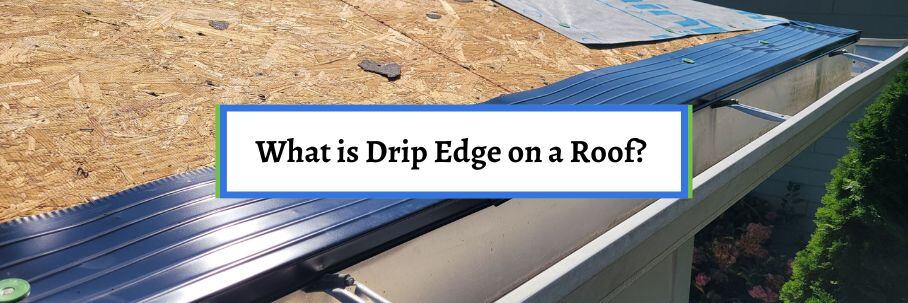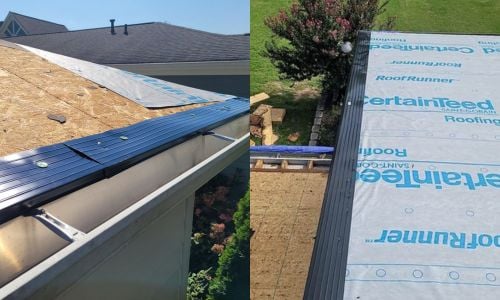What is Drip Edge on a Roof?

Your roof is a combination of different components and roofing materials coming together to protect your home and your family from the elements. Unfortunately, I’ve seen plenty of roofs with one or two missing pieces.
And the most commonly left off is something called drip edge. This is a huge problem, but how are you supposed to know your roof needs it if you don’t know what it is?
For over 30 years, Bill Ragan Roofing has helped homeowners understand the importance of every roofing component, no matter how big or small. That’s why I’ll break down what you need to know about drip edge.
By the end of this article, you’ll have the answers to the following questions:
- What is drip edge?
- Is installing drip edge on your roof really necessary?
- Why would a roofer leave off drip edge during a roof replacement?
- Can you install drip edge on an existing roof?
- How much does installing drip edge cost?
What is drip edge?
Drip edge is metal flashing installed at the edges of the roof to prevent water from getting behind the gutters and underneath the roofing material. Water is guaranteed to rot out the fascia board and edges of the roof decking if it wasn’t installed on your roof.

Even worse, if left unchecked for too long, leaks will develop in your walls and home’s interior. Just know that existing pre-bent aluminum fascia or rake molding can serve as a drip edge.
So, you won't need drip edge if your home has either one because there’s already protection on the edges of your roof. However,
Is installing drip edge on your roof really necessary?
When getting a roof replacement, your drip edge must be replaced. This isn’t just a roofer’s decision; it’s actually one of the most important residential building codes.
According to code R905.2.8.5 of the 2021 International Residential Code: “a drip edge shall be provided at eaves and gables of shingle roofs.”
So, yes, installing drip edge on your roof is absolutely necessary. But it also must be installed correctly to be compliant with the rest of the code.
The rest of code R905.2.8.5 states:
“Adjacent segments of drip edge shall be overlapped not less than 2 inches (51 mm). Drip edges shall extend not less than 1/4 inch (6.4 mm) below the roof sheathing and extend up back onto the roof deck not less than 2 inches (51 mm). Drip edges shall be mechanically fastened to the roof deck at not more than 12 inches (305 mm) o.c. with fasteners as specified in Section R905.2.5. Underlayment shall be installed over the drip edge along eaves and under the drip edge along rake edges.”

Installing it this way is all about keeping your roof completely buttoned up at the edges to prevent leaks. Simply put, drip edge is absolutely required on a roof to prevent a failed home inspection and leaks.
Why would a roofer leave off drip edge during a roof replacement?
Even though drip edge is a crucial roofing component, some less-than-reputable roofing contractors don’t install it right or leave it off entirely. Incorrect installation is often due to laziness, inexperience, or cutting corners to save time.
However, bad and cheap roofers leave drip edge off their estimates entirely to offer a much more appealing price. Most of the time this happens because a homeowner looks for the lowest-priced roof replacement in their area.
But once a bad roofer knows you’re looking for a low price, their ears perk up. I guarantee they’ll find ways to bring their prices down, and one of the easiest things to exclude is drip edge.
I understand that cost and budget are big concerns, but roofs are considered investments for a reason. The last thing anyone needs after spending thousands of dollars on a roof is to spend more on repairs or eventually pay for a new roof way earlier than expected.
Can you install drip edge on an existing roof?
Yes, you can install drip edge on an existing roof. However, it’s a big, complicated, and expensive repair.
First, the starter shingles, normal shingles, and underlayment will be pulled up so the drip edge can be installed. They’ll also check the decking and replace any boards with water damage before installing anything else.
After putting the drip edge flush with the fascia board, the underlayment is reinstalled over it at the eaves and under it at the rakes. Finally, it’ll be fastened with nails through the metal to the decking, and the shingles will be reinstalled.
This process continues wherever drip edge was left off your roof. And remember, it must be installed correctly to be code-compliant.
How much does installing drip edge cost?
How much it costs to install drip edge depends on factors such as roof pitch, the amount required, labor costs, and more. However, the situation also plays a huge role.
Drip edge should always be included in your roof replacement, so it’s factored into the total per square or square foot price. For labor and materials, aluminum drip costs around $2.00 to $3.00 per linear foot when getting a new roof.
If you upgrade to a different metal (steel or copper), it’ll cost more. But as I said, putting drip edge on an existing roof is a complicated and expensive repair.
The same cost factors apply, but it’s a lot easier to install when starting from a completely clear roof deck. Because of this, installing drip edge on an existing roof can cost anywhere from $500 to $3,000.
However, it really depends on how much is getting installed, the makeup of your roof, and the roofer you hire.
What other roofing materials and components will you pay for when getting a new roof?
Now you know what drip edge on your roof is, why you need it, and more. It’s absolutely crucial that your roof has it to avoid leaks and failing a home inspection.
As long as you hire a great roofer, you should have no issues. Drip edge is one of the most important roofing components, but it’s just one piece of the puzzle.
That’s why you need to know the other materials and components your roof needs to keep your home leak-free. After all, you need to know what you’re paying for when getting a roof replacement.
Check out 9 Materials Included With Your Roof Replacement to learn about the rest of the important roofing materials that make up a roof.


